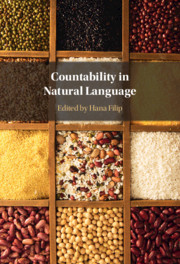Book contents
- Countability in Natural Language
- Countability in Natural Language
- Copyright page
- Contents
- Contributors
- Preface
- Introduction
- 1 Proportional Many/Much and Most
- 2 Quantity Systems and the Count/Mass Distinction
- 3 Counting Aggregates, Groups and Kinds: Countability from the Perspective of a Morphologically Complex Language
- 4 Individuating Matter over Time
- 5 Reduplication as Summation
- 6 Iceberg Semantics for Count Nouns and Mass Nouns: How Mass Counts
- 7 Indexical Inference: Counting and Measuring in Context
- 8 Counting and Measuring and Approximation
- 9 The Count/Mass Distinction for Granular Nouns
- Index
- References
1 - Proportional Many/Much and Most
Published online by Cambridge University Press: 11 June 2021
- Countability in Natural Language
- Countability in Natural Language
- Copyright page
- Contents
- Contributors
- Preface
- Introduction
- 1 Proportional Many/Much and Most
- 2 Quantity Systems and the Count/Mass Distinction
- 3 Counting Aggregates, Groups and Kinds: Countability from the Perspective of a Morphologically Complex Language
- 4 Individuating Matter over Time
- 5 Reduplication as Summation
- 6 Iceberg Semantics for Count Nouns and Mass Nouns: How Mass Counts
- 7 Indexical Inference: Counting and Measuring in Context
- 8 Counting and Measuring and Approximation
- 9 The Count/Mass Distinction for Granular Nouns
- Index
- References
Summary
This chapter concerns the proportional readings of many and most, for example, where many/most students are smart means ‘the ratio of smart students to non-smart students is high/greater than 1:1’. The authors argue for a GQ analysis of proportional most over Hackl’s adjectival analysis based on distributional differences between relative most (the most P) and proportional most (most P). This GQ analysis is also shown to be supported by morpho-syntactically complex realizations of proportional most, such as the Romanian cei mai mulţi ‘the.MPL more many.MPL’ and cele mai multe ‘the.FPL more many.FPL’. Turning to proportional many, they argue that it shares a syntactic position with cardinal many, namely, SpecMeasP below Det. For the semantics of proportional many, building on Solt’s degree-theoretic approach based on measure functions with a cardinality dimension, the authors propose that measure functions themselves can have a proportional interpretation, based on proportional scales, in which the measure of the entity across a certain dimension is evaluated with respect to the measure of a ‘whole’ in which that entity is included.
- Type
- Chapter
- Information
- Countability in Natural Language , pp. 14 - 51Publisher: Cambridge University PressPrint publication year: 2021
References
- 1
- Cited by

